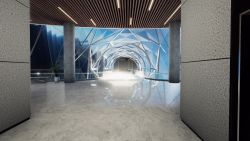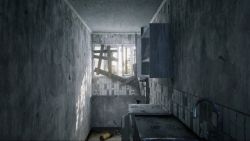|
By flotsam
The Signifier
Playmestudio / Raw Fury
It
took me a while to finish this, as I kept putting it down to play
something else, but it kept bringing me back. Having finished, I then
waited a little while to write this, as I sorted through how I felt
about it.
You
play as Frederick Russell, an expert in Artificial Intelligence and
psychology, and developer of the Dreamwalker (christened Evee), an
experimental technology that enables Frederick to scan a person’s brain
and then “enter” and explore simulations of their memories. Following
the death of Johanna Kast, a high-ranking Executive of the worlds
biggest tech company, the Technology Safeguard Bureau comes knocking on
his door, twisting arms and looking for answers as to what occurred.
So you
get to work.
You
will investigate the real world, but the majority of the game takes
place inside the memory simulations. These are limited at first and
always imperfect. The developmental nature of the technology and the
nature of memories themselves produces fragmented and at times almost
Lovecraftian environments. As well, you can access the memories in
either the objective or the subjective state; the former focuses on
recreating the simulation from sight and sound, filtering out any
subjective elements, while the latter leaves everything in (emotions for
instance). What that means is the objective state is closer to reality,
but neither is what you would call real.
The
ability to view them from two perspectives is integral to progressing
through the game. There are things you can perceive or experience in one
and not the other, and flipping between them is necessary to move
through the game. You can also manipulate various aspects of some
simulations, and you will come to recognise the sorts of things you
might be able to interact with. Your interactive curser will help.
It's
not a straightforward game, which is part of its attraction, but I
confess to feeling lost at times as to what on earth to do next. Evee
can help, integrating uncovered bits and pieces into the simulations to
produce a more complete realm, as can deploying data blocks that you
find. You also get feedback from the game that can help. Looking at
things can produce an insight that might eg. suggest switching to the
other state and looking again.
Nonetheless I did spend a fair bit of time utterly clueless. Sometimes
that was resolved by just doing something that presented itself –
jumping into an avatar for instance – but other times a walkthrough was
essential, the required way forward being a hotspot hunt beyond me.
Having
said that, the nature of the simulations do result in some unique puzzle
solves. A fragmented staircase that isn’t there until viewed properly is
an example, and there are others. Manipulating and using the things you
find (and can inhabit) is necessary to overcome the obstacles to
progression. So too is trial and error, and not in a bad way; do things
to see how the environment works. It's one of the strengths of the game.
It's
visually interesting as well, almost discordant at times. The fractures,
gaps and glitches inside the memories produce realms that can ebb and
flow from mundane to surreal to a cacophony of polygons. More so of
course in the subjective state. It can be disconcerting, but also
fascinating. Again, I thought it was a plus, despite getting confused
about which slippery tunnel to proceed through next.
The
story too is an ambitious one. Political overtones, conspiracy
undertones, the State v. private enterprise; all are built on by choices
you can make as to how you might engage with a number of entities. Near
as I can tell some of those choices do impact the endings you can get.
And then there’s your daughter. It’s a detailed and layered endeavour.
The
game autosaves fairly liberally as you go, and WASD moves you around. A
combination of mouse and keyboard does everything else. You need to be
close enough to a hotspot to generate the active curser, which might be
one of a few actions. Some of your choices are time limited, but I doubt
that will be an impediment to deciding which way you want to go. The
voices are fine, the sound effects effective and the music sparing but
well used.
The
end does come a bit suddenly, and leaves some things up in the air, but
I didn’t actually mind. And you might have a big choice to make.
After
about six hours of playtime, and a bit of reflection, I liked this game.
It has its flaws, but what game doesn’t, and it strives to be different.
Which for me is a reason to play, especially given what it does well.
I played on:
OS: Windows 10, 64 Bit
Processor: Intel i7-9700K 3.7GHz
RAM: Corsair Dominator Platinum RGB DDR4 32GB
Video card: AMD Radeon RX 580 8192MB
GameBoomers Review Guidelines
June 2021
design copyright© 2021
GameBoomers
Group
 GB
Reviews Index GB
Reviews Index |






